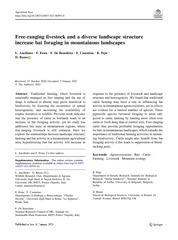Приказ основних података о документу
Free-ranging livestock and a diverse landscape structure increase bat foraging in mountainous landscapes
| dc.creator | Ancillotto, Leonardo | |
| dc.creator | Festa, Francesca | |
| dc.creator | De Benedetta, Flavia | |
| dc.creator | Consentino, Francesca | |
| dc.creator | Bajić, Branka | |
| dc.creator | Russo, Danilo | |
| dc.date.accessioned | 2021-02-10T12:17:07Z | |
| dc.date.available | 2021-02-10T12:17:07Z | |
| dc.date.issued | 2021 | |
| dc.identifier.issn | 0167-4366 | |
| dc.identifier.uri | https://radar.ibiss.bg.ac.rs/handle/123456789/4123 | |
| dc.description.abstract | Traditional farming, where livestock is seasonally managed as free ranging and the use of drugs is reduced or absent, may prove beneficial to biodiversity by fostering the occurrence of spatial heterogeneity, and increasing the availability of trophic resources to wildlife. Previous work indicates that the presence of cattle in lowlands leads to an increase in bat foraging activity, yet no study has addressed this topic in mountainous regions, where free-ranging livestock is still common. Here we explore the relationships between landscape structure, farming and bat activity in a mountainous agricultural area, hypothesizing that bat activity will increase in response to the presence of livestock and landscape structure and heterogeneity. We found that traditional cattle farming may have a role in influencing bat activity in mountainous agroecosystems, yet its effects are evident for a limited number of species. Three pipistrelle species favoured foraging in areas subjected to cattle farming by hunting more often over cattle or fresh dung than at control sites. Free-ranging cattle thus provide profitable foraging opportunities for bats in mountainous landscapes, which remarks the importance of traditional farming activities in sustaining biodiversity. Cattle might also benefit from bat foraging activity if this leads to suppression of bloodsucking pests. | sr |
| dc.language.iso | en | sr |
| dc.publisher | Agroforestry Systems | sr |
| dc.relation | Universita degli Studi di Napoli Federico II | sr |
| dc.relation | Erasmus Grant KA107 | sr |
| dc.rights | openAccess | sr |
| dc.rights.uri | https://creativecommons.org/licenses/by/4.0/ | |
| dc.source | Agroforestry Systems | sr |
| dc.subject | Agroecosystems | sr |
| dc.subject | Bats | sr |
| dc.subject | Cattle | sr |
| dc.subject | Farming | sr |
| dc.subject | Livestock | sr |
| dc.subject | Mountain ecology | sr |
| dc.title | Free-ranging livestock and a diverse landscape structure increase bat foraging in mountainous landscapes | sr |
| dc.type | article | sr |
| dc.rights.license | BY | sr |
| dcterms.abstract | Цонсентино, Францесца; Aнциллотто, Леонардо; Феста, Францесца; Де Бенедетта, Флавиа; Пејић, Бранка; Руссо, Данило; Фрее-рангинг ливестоцк анд а диверсе ландсцапе струцтуре инцреасе бат форагинг ин моунтаиноус ландсцапес; Фрее-рангинг ливестоцк анд а диверсе ландсцапе струцтуре инцреасе бат форагинг ин моунтаиноус ландсцапес; | |
| dc.rights.holder | © 2021, The Author(s). | sr |
| dc.identifier.doi | 10.1007/s10457-021-00591-0 | |
| dc.identifier.scopus | 2-s2.0-85099252541 | |
| dc.identifier.wos | 000606719600001 | |
| dc.citation.apa | Ancillotto, L., Festa, F., De Benedetta, Fl., Cosentino, F., Pejic, B., & Russo, D. (2021). Free-ranging livestock and a diverse landscape structure increase bat foraging in mountainous landscapes. Agroforestry Systems, DOI:10.1007/s10457-021-00591-0. | |
| dc.citation.vancouver | Ancillotto L, Festa F, De Benedetta Fl, Cosentino F, Pejic B, Russo D. Free-ranging livestock and a diverse landscape structure increase bat foraging in mountainous landscapes. Agrofor Syst. 2021;DOI:10.1007/s10457-021-00591-0 | |
| dc.type.version | publishedVersion | sr |
| dc.identifier.fulltext | https://radar.ibiss.bg.ac.rs/bitstream/id/8094/bitstream_8094.pdf | |
| dc.citation.rank | M21 |

